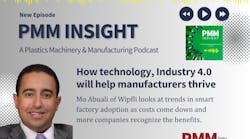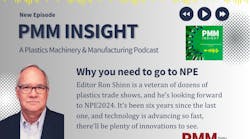Processors who want to trim their electric bills need to think big — really big.
“I hate to say this, but the biggest thing that people have done is install LED lighting,” said Robin Kent, founder and managing director of Tangram Technology, a U.K. plastics industry consultancy. “Have you ever heard the phrase, ‘Rearranging the deck chairs on the Titanic?’ ”
Related stories: Tracking energy use lets processors take charge; Harbec succeeds in carbon-neutral quest; Solar, battery storage bring savings to Iowa blow molder
The payback on installing LEDs is quite good, he said. However, lighting constitutes only about 5 percent of an average plastics processor’s electricity consumption. There are bigger savings elsewhere. When Kent conducts an audit, he is looking for ways to save about 30 percent on electricity costs.
The starting point is understanding which pieces of equipment consume the most electricity. That requires installing submeters that can pinpoint the biggest energy-guzzlers. However, most plastics processors haven’t invested in that technology.
“They don’t have a clue where their energy is used, when it’s used, or how it’s used,” Kent said. “It’s just one great big pot. I would like to see more energy monitoring, so we know where it’s being used, and once we know where, we can start to figure out how we can reduce it.”
Most plants rely on the electric meter installed by the utility provider to measure energy consumption. It provides information about total energy consumption and shows how much electricity is used at specific times of the day, but it doesn’t show which pieces of equipment are consuming the most energy.
“There’s a bundle of systems out there for energy monitoring,” Kent said. “It’s just that people aren’t putting them in. … You go into the average factory, and they’ve got time clocks and swipe cards, and they’ve got people calculating wages, and then you ask them about their energy use, and they go, ‘We look at the bill at the end of each month.’ ”
Processors can use one submeter to determine how much energy all their injection molding machines are consuming or install submeters on each machine. The same is true for other equipment, like dryers and chillers. The more detailed the information, the more beneficial it can be. However, companies need to weigh the costs of the metering equipment against the potential payback.
Kent recommends that a company budget 2 percent of its annual energy bill to pay for metering systems. For example, a company spending $2 million per year on electricity should set aside $40,000.
“It's a question of allocation of resources,” Kent said. But when a company installs energy-monitoring systems, “you start seeing behavioral changes, providing you publicize the data.”
Processors in Europe place a greater emphasis on energy conservation and sustainability, but U.S. processors become very interested when Kent tells them how much money they can save.
“They’re all concerned with saving money; that’s what makes the world go around, at least as a company,” Kent said. “There are lots of people who tried to sell … sustainability as the main message. That’s, ‘Let’s save energy for the sake of the environment,’ but the thing that really ticks the boxes for plastics processors is energy management to save money.”
Replacing old primary equipment, such as injection molding machines and extruders, with new models can be the biggest energy-saver. For example, today’s hydraulic injection molding machines on average will use 30 percent less energy than comparable machines made 25 years ago. If a molder replaces old presses with new, all-electric injection molding machines, the energy savings could jump to between 40 percent and 60 percent, he said.
Replacing old DC-motor extruders with new models featuring AC motors with variable-frequency drives can save significant amounts of energy. And today’s all-electric blow molding machines use about half the energy of older hydraulic models.
However, because of the up-front cost, replacing equipment usually isn’t Kent’s top suggestion. He generally recommends improving the efficiency of older machines rather than buying new ones.
“I worry about getting the old machines running as efficiently as possible because you can’t go into a factory with 20 injection molding machines and say, ‘To be energy-efficient, you’ve got to replace your 20 injection molding machines.’ That won’t fly,” Kent said. “They won’t even listen. I’d be walking out the door before I’ve signed the visitors’ book.”
Kent looks for investments with a payback of 18 months or sooner. He focuses on either replacing compressors, chillers, dryers, granulators and other auxiliary equipment with newer, more energy-efficient models, or adapting the existing equipment so that it runs in a more energy-efficient manner. For example, at one factory, within only eight minutes of inspection, he identified compressed air leaks that cost the company about $8,000 per year in wasted energy. He recommended that the company investigate further, because identifying and fixing additional leaks could save thousands of dollars more annually.
“I can make real hits really quick there,” Kent said. “Then I start talking to them about the machines.”
Kent advises some clients to “start thinking” about replacing old primary equipment because, while the old machines might still work, they could be costing the company 30 percent to 50 percent more for energy than is necessary.
Kent has helped some processors in the U.K. replace hydraulic injection molding machines with new, energy-efficient models paid for via low-interest loans from the Carbon Trust, a government-backed organization that helps businesses reduce their carbon footprint. Kent said plastics machinery manufacturers could boost equipment sales by structuring similar low-interest loans for their U.S. customers.
Alternatively, Kent said that OEMs could sell or lease machines with monthly payments low enough that the energy savings would more than cover the costs. However, that would be a change for equipment manufacturers, which normally don’t offer financing for their equipment.
“If you’re touting your new injection molding machine because it’s energy-efficient, why not put your money where your mouth is and say, ‘We will make it so that the repayments are less than what you save?’ ” Kent said.
The arrangement would be cash-flow positive for plastics processors who also would have a factory filled with new machines.
“What’s not to like?” Kent asked.
While some companies look to alternative energy sources to reduce their carbon footprint or energy costs, Kent said he doesn’t recommend on-site solar or wind energy projects. In most cases, processors’ sites are not large enough to accommodate the solar panels and wind turbines necessary to make a significant reduction in energy purchases. The payback times are somewhere between five and nine years, which is too long for many companies to consider, he said.
Natural gas can be an economical option.
“You can use gas for everything,” he said. “You can use gas for electricity; you can use gas for heating, and you can use gas for cooling.”
The technology, known as combined cooling, heating and power — or tri-generation — uses gas, which costs about a quarter of the price of electricity. The gas fuels a turbine for electricity generation, and the exhaust heat is used to produce steam for heating the plant or is transported to an absorption chiller to cool water and air.
“It does have a high CapEx [capital expenditure], however,” Kent said. “It’s not a cheap project.”
Kent offers detailed descriptions of his energy-saving techniques in his book “Energy Management in Plastics Processing: Strategies, Targets, Techniques, and Tools,” which is available through Amazon and other booksellers.
Bruce Geiselman, senior staff reporter
Contact information:
Tangram Technology Ltd., Hitchin, England, 44-1462-437-686, [email protected], www.tangram.co.uk






